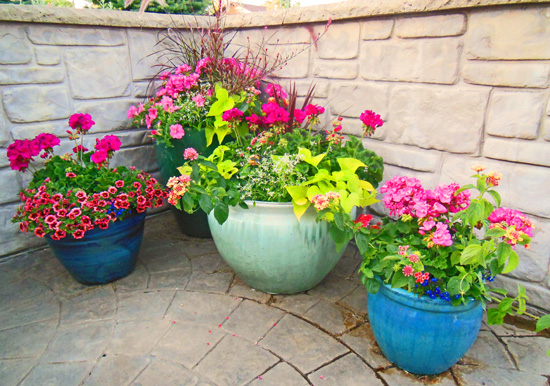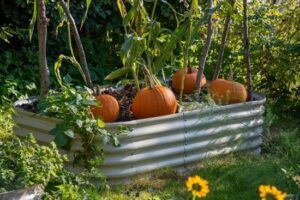
Lantana, with its vibrant clusters of flowers and ability to attract pollinators, is a popular choice for container gardening. Whether you’re looking to add a splash of color to your patio or create a mobile garden on your balcony, planting lantana in containers offers versatility and visual appeal. In this article, we’ll explore the art of companion planting with lantana, guiding you through the process of selecting complementary plants and creating stunning container arrangements.
I. Introduction
A. Overview of Lantana Plants
Lantana, belonging to the Verbenaceae family, is a genus of flowering plants native to tropical regions of the Americas and Africa. Known for their dense clusters of small, brightly colored flowers, lantanas are prized for their long blooming period and ability to thrive in hot and dry conditions. They come in a variety of colors, including shades of red, orange, yellow, and purple, making them a favorite among gardeners seeking a splash of color in their landscapes.
B. Advantages of Growing Lantana in Containers
Growing lantana in containers offers several advantages, particularly for those with limited garden space or challenging growing conditions. Containers allow for greater control over soil composition, drainage, and placement, making it easier to provide lantana with the optimal growing environment. Additionally, container-grown lantanas can be moved around to maximize sunlight exposure or create visual focal points in outdoor spaces.
C. Purpose and Scope of the Article
The purpose of this article is to provide guidance on selecting companion plants for lantana containers, enhancing both the aesthetic appeal and overall health of your container garden. We will discuss the concept of thriller, filler, and spiller plants and explore considerations for successful container gardening with lantana, including sunlight requirements, soil composition, and watering techniques.
II. Complementary Plants for Lantana Containers
A. Thriller Plants
Thriller plants, also known as focal points, are tall, upright plants that add vertical interest and drama to container arrangements. When paired with lantana, thriller plants create a dynamic visual contrast, drawing the eye upward and adding depth to the composition. Examples of thriller plants that pair well with lantana include ornamental grasses, spike plants (e.g., Dracaena), and tall flowering perennials such as salvia or verbena bonariensis.
B. Filler Plants
Filler plants are medium-height plants that fill in the space between thriller and spiller plants, adding volume and texture to container arrangements. When selecting filler plants for lantana containers, consider options that complement lantana’s vibrant blooms and foliage. Compact annuals like petunias, marigolds, and zinnias work well as filler plants, providing a burst of color and filling out the container with lush foliage.
C. Spiller Plants
Spiller plants are trailing or cascading plants that spill over the edges of containers, softening the edges and creating a sense of flow and movement. When paired with lantana, spiller plants enhance the visual impact of the arrangement and help integrate the container into its surroundings. Ideal spiller plants for lantana containers include trailing varieties of ivy, bacopa, sweet potato vine, and cascading petunias.
III. Considerations for Container Gardening with Lantana
A. Sunlight Requirements
Lantanas thrive in full sun and require a minimum of 6-8 hours of direct sunlight per day to bloom profusely. When selecting companion plants for lantana containers, choose species that have similar sunlight requirements to ensure harmonious growth and development. Place containers in a location that receives ample sunlight throughout the day, such as a south-facing patio or balcony.
B. Soil Composition and Drainage
Good soil drainage is essential for lantana container gardening, as excessive moisture can lead to root rot and other fungal diseases. Choose a well-draining potting mix specifically formulated for container gardening, or amend garden soil with perlite or coarse sand to improve drainage. Additionally, consider adding organic matter such as compost or peat moss to enrich the soil and provide essential nutrients for plant growth.
C. Watering and Maintenance
Maintaining proper moisture levels is crucial for the health and vitality of lantana and its companion plants. Water container-grown lantanas thoroughly whenever the top inch of soil feels dry to the touch, allowing excess water to drain freely from the bottom of the container. Avoid overwatering, as soggy soil can suffocate plant roots and promote fungal diseases. Monitor container moisture levels regularly, especially during hot and dry weather, and adjust watering frequency as needed.
IV. Planting and Arrangement Tips
A. Choosing Container Size and Type
Select containers that are large enough to accommodate the root systems of both lantana and its companion plants, with adequate drainage holes to prevent waterlogging. Consider the mature size of each plant when choosing container size and opt for containers that provide ample room for growth. Additionally, choose containers that complement the aesthetic style of your outdoor space, whether it be traditional terracotta pots, modern ceramic planters, or rustic wooden crates.
B. Designing Aesthetic and Functional Arrangements
When arranging plants in containers, consider both aesthetic appeal and functional aspects such as plant height, color contrast, and texture. Place thriller plants towards the center or back of the container, fill in the space with filler plants, and trail spiller plants over the edges to create a balanced and visually appealing composition. Experiment with different plant combinations and container arrangements to find the perfect balance of form and function for your lantana containers.
C. Monitoring Growth and Making Adjustments
As plants grow and mature, they may require adjustments to maintain optimal growing conditions and visual balance. Monitor the growth of lantana and its companion plants regularly, pruning back any overgrown or leggy stems to encourage bushier growth and promote airflow. Replenish soil nutrients as needed with organic fertilizers or compost, and repot plants into larger containers if they outgrow their current space. By staying attentive to the needs of your container garden, you can ensure long-term success and enjoyment of your lantana and its companion plants.
V. Conclusion
In conclusion, planting lantana in containers offers a versatile and visually stunning way to incorporate this vibrant flowering plant into your outdoor space. By selecting complementary plants and paying attention to key considerations such as sunlight, soil, and watering, you can create beautiful and thriving container arrangements that enhance your patio, balcony, or garden. Experiment with different plant combinations and container designs to discover the perfect pairing for your lantana containers, and enjoy the beauty and benefits of container gardening year-round.



